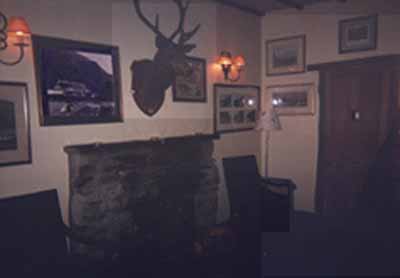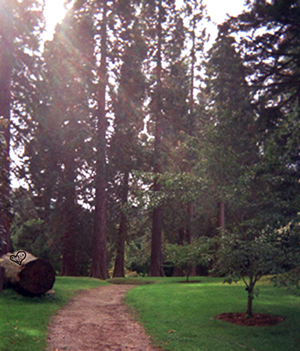Travelogue:Scotland
Episode 6: Final days
Loch Eck, Invararey, Blairmore
Sunday, September 3rd:
The major event on this day was a bustrip along the eastern shoreline of Loch Eck and beyond to the town of Invararey ( not to be confused with Inverary, which is also in Scotland). In an interview the Duchesse d'Antan is quoted as saying : "Loch Eck is part of my DNA and I cannot do without it.."
It rained for most of the day, with only brief interludes of relief. What one could see from the interior of the bus was hardly idyllic. On the next day, when I paid a visit to the Coylet Inn on its shore, the bright sunlight made it easier to confirm the striking beauty of the natural setting.
On both occasions I used up an entire disposable camera. A new one was begun for snapshots of Invararey, a picturesque town that has been intentionally preserved in the style of the 18th century to encourage them . On the next day, following a series of pictures of the interior of the Coylet Inn, the film remaining in this camera was used up of along the shores of Loch Eck , with (unfortunately) only a single frame left over for the Benmore Gardens.
Looking over the two sets of images, those of Loch Eck on a rain-swept afternoon, the other in bright sunlight, my feeling is that the views of the loch in bad weather are even more spectacular than those one sees in excellent weather. The magnificent scale of the cosmic drama brings to mind scenes such as King Lear's night out in the storm, bare-headed and at the mercy of the elements. This may also be what Shakespeare has in mind in Macbeth, when he refers to the Scottish landscape as "the blasted heath". Several examples from both excursions are presented below. Notice how even the droplets of rain condensing upon and running down the plate glass windows convey an additional suggestion of grandeur to the spectacle.
One has to observe Loch Eck under both conditions to fully appreciate the great love the Duchesse feels for it. As she has stated elsewhere: "I've played on its banks, picnicked on its beaches, swum in its chilly unsalted depths, cycled round it, drunk it, got drunk near it, kissed in boats in it (the rest has been deleted for discretionary reasons) ..."
Series I: Loch Eck In Summer Sunlight
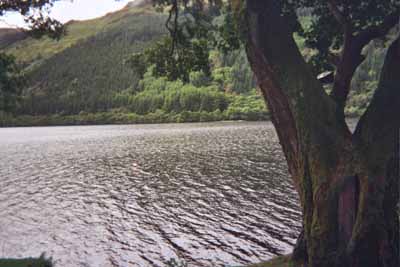
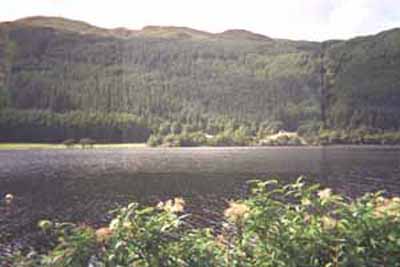
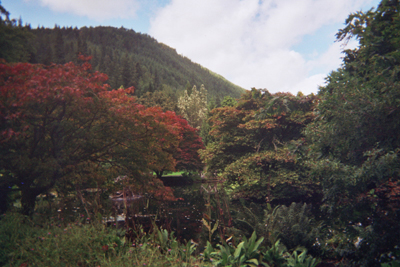
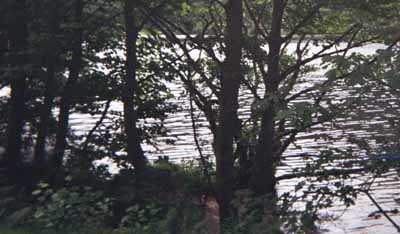
13 Ways of Looking at a Tree on the Shores of Loch Eck
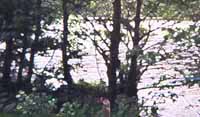
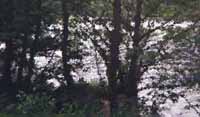
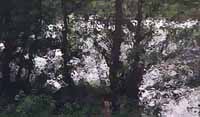
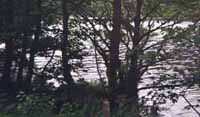
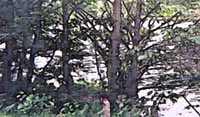
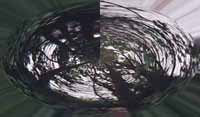
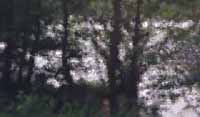
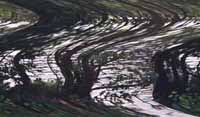
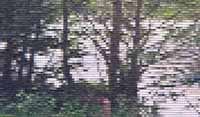
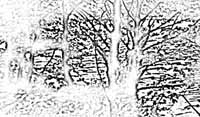
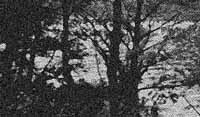
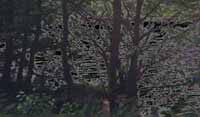
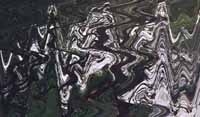
Series II:Loch Eck in Summer Rain
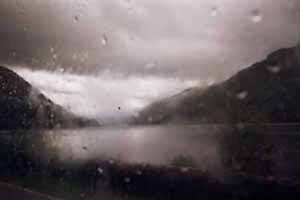
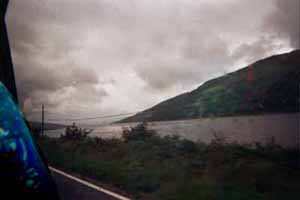


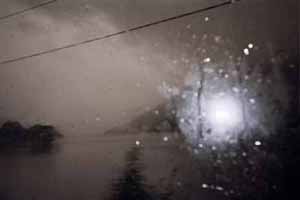
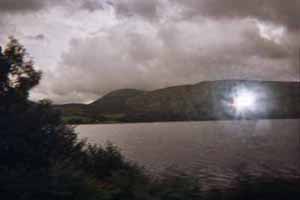
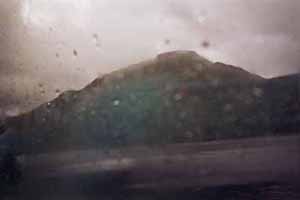
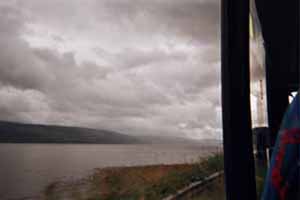


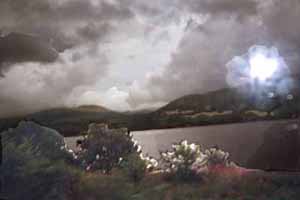
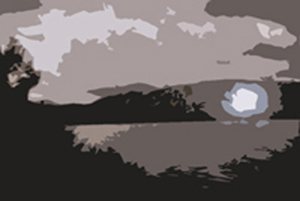
Invararey
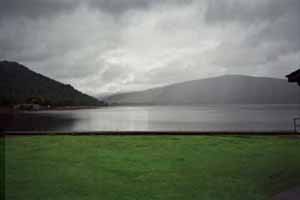
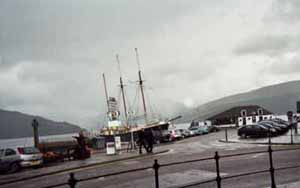
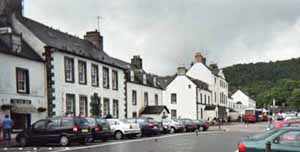
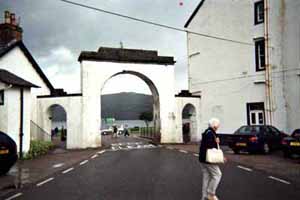
September 4:
Recognizing that I would be leaving for the Loch Lomond youth hostel the next morning , my last day on the Cowal Peninsula was given over to an expedition in search of traces of the presence of the Duchesse d'Antan. At least once a year she and her mother, Delphia Legis, make return visits (not always at the same time ) to the log cabin in the woods in back of Kilmun where she grew up. A secret hope was that I would find her mother eating in a restaurant in Dunoon. As for the Duchesse, she can be anywhere in the world at any time, supporting serious causes, holding sumptuous parties or entertaining everyone from the rich and famous to the poor and lowly. ( In fact I'd learned from a private source that, during my two weeks in Scotland, she had been on the Canary Islands, handing out relief supplies from the back of a UN truck after a recent volcanic eruption.)
The Coylet Inn, Loch Eck
What information I had about her presence in the area around Loch Eck was dated August, 2003. This was the press coverage of the reception, following her secret marriage to her 6th husband, a minor princeling of the Croatian royal house in exile, in the Coylet Inn. The marriage had to be performed in secret, to evade both the attentions of Balkan spies and the hostilities of certain in-laws, Bourbon connections to the duchy of Antan, who resent any association, however remote, with the dethroned Habsburgs. There was also a certain amount of danger from relatives of her second husband, Porfiry Alexandrovsky, still smarting from the way in which she had dumped him in Magnitogorsk in the 90''s and simply disappeared. In contrast, the reception afterwards at the Coylet Inn was a high publicity event, if not open to the public, starring international glitterati trucked in from faraway places.
The Coylet Inn lies on the eastern shores of Loch Eck about 9 miles north of Dunoon. Giddy from the festive atmosphere, flush with champagne and no doubt a bit dizzy from dancing for 4 hours with her new mate, she is alleged to have told a reporter for the Daily Mirror that the Coylet Inn was "the most beautiful place in the world." No small praise from a woman who is as likely to be on Macchu Picchu, as she is to be in the jungles of Borneo.
The inn is some 2 miles north of Benmore Gardens, an astounding botanical paradise that I was too exhausted to properly investigate in the short time available to me. The most I was able to do, after walking the stretch of road between the inn and the gardens, was a brief inspection of the groves of gigantic trees near the entrance.( I took the opportunity to engage in some petty vandalism, which we will come to in a moment. ) At about 12:30 the bus driver left me off in front of the Coylet Inn after a journey of half an hour or so out of Dunoon. The weather was beneficent, unwindy, sunlite, mildly clouded, warm and clear. Had it not been in Scotland it might have been sun-baked, but global warming has not proceeded that far as of yet. The Coylet turned out to be a typical country inn for persons of ample means. It was charming, certainly, though hardly exceptional in its category. Neither the stag's head ( lifted perhaps from a descendant of the gentlestag in the ballroom of Auchendennan House) over the fireplace , nor the marinated antique wainscoting in the lobby and dining-rooms indicated novelty. Although it was the lunch hour the dining-room was all but deserted. I later learned that the Coylet Inn doesn't serve lunch on Mondays. Only 3 persons, probably guests at the Inn, were sitting in front of drinks at a table. I thought that one of them might be the owner. "No", he replied, "the staff is in back".
"In back" could mean anywhere, so I began wandering around the first floor until eventually I landed up in the kitchen. My entrance came as a surprise to 3 persons working around a table preparing food for dinner later than evening. Among them was a darling young girl in her 20's. Speaking in a thick Polish accent, she sharply reminded me that I was in the kitchen, clearly the wrong place to be either for stranger or guest. Despite this faux-pas she was not unfriendly to me, and followed me back into the lobby. Her name was Kasha. Slender, bright blond hair, pale features, plain black dress working against rosy cheeks. A reasonable conjecture is that she, like Kierke, is a student working on the holidays before returning to the university. I told her, truthfully, that I edit an On-Line magazine which often publishes travelogues. The next one would be based on my two weeks in Scotland.
Did she know that the Duchesse d'Antan had been married here only a few years ago to a member of the minor Croatian nobility? Yes, she did she said, but cautioned me to speak in a low voice, given that all Eastern European conspiracies are linked in a hierarchy governed by an ultimate conspiracy whose membership is unknown to the greater world. There'd recently been some trouble involving unfriendly visits by members of the Croatian royal house in exile. She had no comment to make when I asked her if all Polish plesiosaurs were males.
Did she know that the Duchesse d'Antan had described the Coylet Inn as "the most beautiful place in the world?" Although she replied "yes" (with positive head-nodding) it was my impression that her command of English was limited and, like most of us when confronted with a foreign language, she just kept saying "yes" to be agreeable. In any case she raised no objections to my taking pictures of everything in sight so that I could late compare the beauty of the Coylet with that of comparable inns. She drew the line however when I asked if she would permit me to take a photograph of her. Kasha would not allow her picture to appear in the Internet (Eastern European conspiracies, etc.)
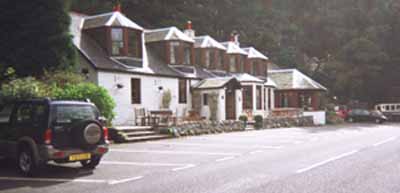
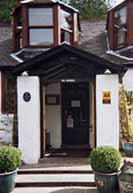
The present owner of the Coylet Inn was not the same one who'd been in charge, an old friend of the Duchesse, at the time of her wedding. She was in Dunoon for the morning and was expected back in about an hour. I didn't want to wait that long, so bidding farewell to this shayne maidel , I began the two mile trek south to the Benmore Gardens.
Now I could see for myself why the Duchesse had called this locale "the most beautiful place in the world". She wasn't referring to the Inn, but to the Loch. The views along the shores of Loch Eck are magisterial in their beauty, combining large expanses of dark anxious waters with chains of lordly mountains, dazzling meadows, clouds , truly a vision of Paradise. The experience of walking past them must be lived, the pictures displayed above give no more than an impression of what this can be.
Benmore Gardens, Strone, Blairmore
As one finds so often in real life, the logistics of the walk itself turned out to be among the nastiest in recent memory. The narrow two lane highway edges the sedge - and no birds sing!. There is virtually no buffer zone for pedestrians. In several places it virtually cleaves the lip of the lake. Cars zip along in both directions as if they own the world, obliging me frequently to cross over from the right to the left side, to negotiate sharp bends in the road and find footholds. One had to pay close attention to avoid trenches and puddles, because for some reason 1x1 foot blocks of turf have been cut out of the sod at regular intervals. These were filled with water. However compelling, contemplation of the ravishing beauties of nature had to give way to considerations of immediate survival.
A walk that ought to have taken 40 minutes at most lasted for more than an hour. Eventually, as I approached the entrance to the Benmore Gardens, the green sward on each side of the road did broaden into an acceptable margin.
I am unable to report on these world renowned gardens as I was too exhausted to do more than stroll about the groves just beyond the entrance. The gigantic trees are definitely awe-inspiring and if I ever return to this region, which I hope to do, the Gardens are at the top of my list. Contact with the nearest bench sent me into a semi-doze. All I have to show from my visit there is this one photograph. Notice the huge stump to the lower left. The strange markings on its surface were put there by myself, no doubt breaking some ordinance in the process.
Isolating and enlarging this portion of the photograph makes it possible to read the message on it:
"R.L.
l.
L.M.
a.k.a .
D. d'A."
That is to say:
"Roy Lisker
loves
Lucinda McDougal
also knows as
(the) Duchesse d'Antan"
By 3 PM I was standing at the gate of the Benmore Gardens, waiting for the bus to Blairmore and the Gallimaufry Gallery. It arrived at 3:20. For the next half hour I traveled through more charming scenery surrounding the towns of Kilmun and Sandbank - I don't think one can call its countryside as we encountered no farmland - until coming to the town of Strone. Gears grinding, it gyrated counter-clockwise to mount a steep hill all the way to the top.
There I beheld an old church of chilling aspect and foreboding presence, with tall blackened spires and gloomy facade, just the sort of thing one would expect to find in 17th century Scotland. The bus halted outside a tall wrought-iron fence. The driver stepped out and didn't return for another 10 minutes, leaving our contingent of half a dozen passengers to our own devices. .
About 30 elementary schoolchildren wearing red uniforms came out of the church buildings and began walking down a winding road to the gate. They gathered together in a group as their teachers counted them, before stepping into the bus. Compared to their American schoolchildren they were marvelously well-behaved! One of the teachers came on board, counted the lot, and saw to it that they'd all given their tickets to the driver.
I thus learned that this bus turns into a school bus at 3:30, when it reaches Strone. Between Strone and Blairmore it made frequent stops, letting off children singly or in small groups. We reached the Gallimaufry Gallery at around 3:45.
The Gallimaufry Gallery faces the waterfront across the highway in a tiny shopping area, if one can call it that, including a tiny grocery store and a charity shop named "The Glory Hole". The use of the word "glory" in today's world normally indicates either religion or nationalism. Although this might not be so in the Scottish dialect, I suspect a religious connection. It is something of a surprise to find so charming an art gallery in such complete isolation from any surrounding settlement or commercial activity. Stepping inside one enters a different world, art gallery for paintings and drawings, a current exhibition, card shop, cafe and bakery. Tourists who haven't got the time to sign up for a free account with the local libraries, or who don't realize how easy this is, can also use the Internet here for a moderate price.
Cards, graphics, craft items and paintings are almost entirely by local artists, of which there are a great many living on the Cowal Peninsula. In this respect it reminds me of Ulster County in New York State. Its present manager is Hilary Barr. Jean Thompson, the owner owner, now lives in New Zealand. .
On my first visit to the Gallery the previous Friday, I'd shared a table at the cafe with 3 elderly women and a volunteer. They were out on an excursion in a blue van owned by an organization called "Befriending the Elderly". The van was outside the building, painted with the name of the organization and its logos. (Even as no one listens to an expert nowadays unless he or she has tenure in some university, so no social service organization worthy of mention comes unequipped with its logos and van!)
I enjoyed chatting with them. The elderly ladies refused to pronounce "Connecticut" correctly, stressing the second "c", and I decided that it if it didn't matter to them it didn't matter to me. Why doesn't Joe Liebermann campaign to remove the c from the name of our state instead of depressing mankind by running for senator? The volunteer was a compassionate young woman happy to listen to an account of what I'd been up to in Scotland since arriving on August 25th. When I gave her the names of several places around Dunoon I'd been given, which are famed for their hiking, she was able to tell me that they were all on the other side of the peninsula and completely inaccessible by any means other than a car.
Hilary Barr was alone in the gallery on my second visit there. She enjoys engaging in conversations with her customers. Over a cup of coffee and piece of carrot cake we chatted for 20 minutes while awaiting the bus returning to Dunoon. Hilary reminisced about the American naval bases in Faslane, and in Coulport, visible just across the estuary. She said that the Americans were a welcome addition to the area, though not, of course, because of their submarines. They enrolled their children in the local schools, while their wives were very active in community organizations such as the PTA. The only drawback was that property values went down, because landlords allowed the houses in which the sailors were living to fall into neglect. After the bases were eliminated in 1992 these houses could be bought up for almost nothing. The new owners have been renovating them over the last 15 years and they have been very valuable.
I was able to veil my questions about the Duchesse d'Antan in such a way that she would not suspect my motives. Hilary told me that the Duchesse is a frequent visitor to the Gallimaufry Gallery when she is staying in the region, coming in, sometimes with her mother, sister and husband as often as once daily. She likes them very much. Away from the spotlight they are unpretentious, ordinary people and quite charming. Many famous people keep summer cottages in Argyll, where they can escape the pressures of celebrity they find weighing oh them in London or Edinburgh (or, I silently added, in Middletown.)
This information has given me a way of encountering the Duchesse d'Antan: far-fetched and expensive, but it works. I need only move to Scotland for one year and arrange to take a 4-hour coffee break at the Gallimaufry Gallery every day. (It is reasonable to assume that the McDougle family goes there in the afternoons between the hours of 12 and 4.) There must be better ways, but its not so easy, either, to rush off to East Timor, Bangla-Desh or Uzbekistan at a moment's notice.
On Tuesday, September 5 I returned to the Loch Lomond hostel. The next day in Balloch was spent collecting further evidences of the existence of Mandy to present to my scientific colleagues at Wesleyan University. I took the train into Glasgow on the morning of September 7th.
The train pulled into Charing Cross Station at 9:30 AM. A brief foray along Sauchiehall Street led me to an Italian coffee shop very close to Park Terrace, where I would be staying at the Youth Hostel for my final night in Scotland. Noticing a quaint ruddy post of an English postal box standing just outside the door of the shop, I took a postcard with a Charles Rennie Mackintosh painting on its upper surface from my backpack. On the other side I wrote a message to the Duchesse d'Antan, at Chateau du Courge, Antan, France. In it I say farewell ( for the moment) to Scotland, and let her know how much I'd enjoyed my short visit to her homeland. It is signed : "From Roy to his my cherished sweetheart, the Duchesse d'Antan".
